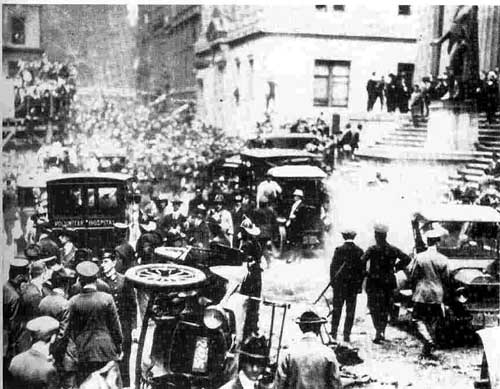|
||
|
||
| The old is new: this was the scene outside the House of Morgan in New York moments after a bomb exploded in September 1920. |  |
| THE HOUSE OF MORGAN An American Banking Dynasty and The Rise of Modern Finance By Ron Chernow Morgan Entrekin/Atlantic Monthly 812 pp. $29.95 IT IS fitting that Ron Chernow's new book on the Morgan banking dynasty should appear within weeks of the smash-up of Drexel Burnham Lambert. The Drexel and Morgan names are among the oldest in American finance, and their fates have often intertwined. In fact, J.P. Morgan's first step toward financial pre-eminence was his partnership with Anthony Drexel. More than a century later, separate investment houses bearing the two family's names became aggressive practitioners of take-over tactics like the leveraged buyout, or LBO. Both Drexel Burnham Lambert and Morgan Stanley advised Henry Kravis in last year's $22.5 billion RJR Nabisco deal, the largest LBO ever. After Drexel Burnham Lambent became ensnared in a string of criminal charges stemming from the activities of its junk bond Wunderkind, Michael Milken, it relinquished junk bond leadership to Morgan Stanley, which briefly, became the top purveyor of high yield-high risk paper in America. The recent junk bond-related bankruptcies of Drexel Burnham Lambert and Campeau have made many people wonder how American finance came to this pass. While it deals only tangentially with Drexel et al, Ron Chernow's The House of Morgan offers a long look at how the contemporary financial landscape came into being. The House of Morgan is the first book on the Morgan banking' dynasty that carries the story through to the late 1980s, and the first to make use of the papers of such crucial 20th-century Morgan figures as Thomas Lamont. The result is a panoramic and well researched look at the most powerful family of bank in America over the last century. Along with the merchant banking activities of the Morgans, The House of Morgan details the sibling firms (mostly limited partnerships, at least in the early days) that have served as vehicles for Morgan business around the world. These include J.S. Morgan & Co., Drexel Morgan, Morgan Harjes, J.P. Morgan & Co., Morgan Grenfell, Morgan Stanley and Morgan Guaranty. Chernow is more interested, however, in the characters of the dynamic men who have led the Morgan empire. First there was shrewd Junius Spencer Morgan, who glimpsed the future shape of banking, and relentlessly drove his son to succeed. Then there was John Pierpont Morgan, who took all his father gave him (including the $5 million capital he needed for his initial stake in Drexel Morgan) and used it as the armature upon which to fashion a new economic order with his organization of the U.S. Steel Trust in 1901. Following the line from Jupiter, as J.P. was sometimes called, down to the professional managers who currently run the various Morgan banks, one is struck by the declining scale of the figures. The modern Morgan bankers seem very small and generally undistinguished. "Contrary to the usual law of perspective," as Chernow puts it, "the Morgans seem to grow larger as they recede in time." IN FACT, one of the most surprising things that emerges from The House of Morgan is that the Morgan banks were actually much more principled in the late 19th century when they were vituperated by populists as the evil heart of the Money Trust. J. P. Morgan might thunder, "I owe the public nothing," but his banks' service inspired incredible loyalty among clients. A century later, Chernow shows Morgan Guaranty apparently feeding on its weaker clients, throwing them as takeover bait to its bigger clients. Chernow has a supple, refined style that more than once rises above the counting house floor. The supposed thesis of The House of Morgan -- that there will never be another bank as powerful, mysterious or opulent as the old house of Morgan -- is just eyewash though. What this book does best is to portray the Shiva-like arms of Morgan as they shaped and were shaped by modern capitalism. "The Empire the Morgans Built" originally appeared in the March 18, 1990 Washington Post Book World.© Copyright 1990 Bruce Brown
© Copyright 1973 - 2020 by Bruce Brown and BF Communications Inc. Astonisher and Astonisher.com BF Communications Inc. Website by Running Dog |
||||||